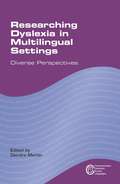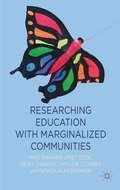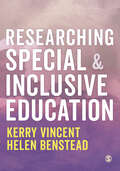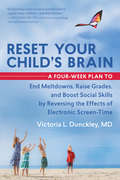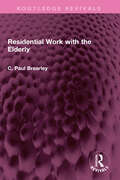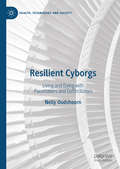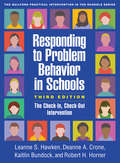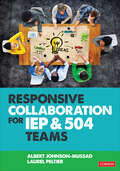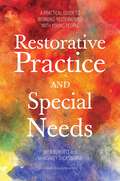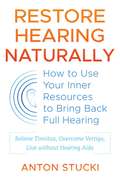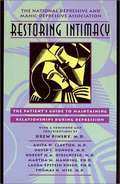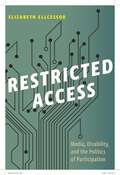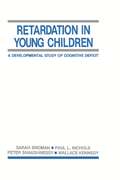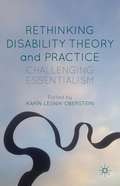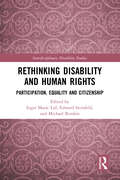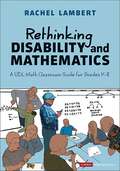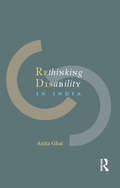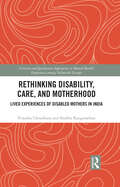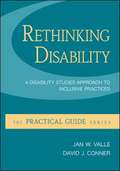- Table View
- List View
Researching Dyslexia in Multilingual Settings
by Deirdre MartinThis volume draws together current research on dyslexia and literacy in multilingual settings across disciplines and methodologies. The contributors, all internationally recognised in the field, address developmental and acquired literacy difficulties and dyslexia in a range of language contexts including EAL/EFL. The book uses theories and analytical frameworks of a critical nature to reveal prejudicial social practices, and suggests future research directions towards a critical re-consideration of current understandings of dyslexia in multilingual settings, with a view to foregrounding the potential for interdisciplinarity. The book also suggests ways forward for evidence-informed practice, and it will be a valuable resource for researchers, practitioners and students alike.
Researching Education with Marginalized Communities
by Geoff Danaher Mike Danaher Janet Cook Phyllida Coombes Patrick Alan DanaherThis collection provides evidence-based strategies for conducting effective and ethical education research with individuals and groups who are marginalised from mainstream society. The book explores circus and fairground communities, disabled vocational education students, environmental lobbyists and retired people from across the globe.
Researching Special and Inclusive Education
by Kerry Vincent Helen BensteadResearching in special and inclusive education can be challenging due to the frequent difficulties in eliciting the views of individuals identified with SEND. This book will give students the confidence to be creative, flexible, and innovative when it comes to planning research, particularly with children and young people within special and inclusive education. Students will be guided through each step of the research process, from the development of a research question to ethical considerations, methodologies and data analysis, before being led through the many practical issues that need to be considered when planning, executing and writing up research in this field, including good research practices, solutions to possible dilemmas and adapting methods appropriately. Kerry Vincent is a Senior Lecturer in Inclusive Education at the University of Canterbury, New Zealand. Helen Benstead is a Senior Lecturer in the School of Education, and Programme Leader of the MA Special Educational Needs, Disability and Inclusion at the University of Sunderland.
Researching Special and Inclusive Education
by Kerry Vincent Helen BensteadResearching in special and inclusive education can be challenging due to the frequent difficulties in eliciting the views of individuals identified with SEND. This book will give students the confidence to be creative, flexible, and innovative when it comes to planning research, particularly with children and young people within special and inclusive education. Students will be guided through each step of the research process, from the development of a research question to ethical considerations, methodologies and data analysis, before being led through the many practical issues that need to be considered when planning, executing and writing up research in this field, including good research practices, solutions to possible dilemmas and adapting methods appropriately. Kerry Vincent is a Senior Lecturer in Inclusive Education at the University of Canterbury, New Zealand. Helen Benstead is a Senior Lecturer in the School of Education, and Programme Leader of the MA Special Educational Needs, Disability and Inclusion at the University of Sunderland.
Reservations for Death (Duncan Maclain Mystery #9)
by Baynard KendrickWhen Belden Clark, a major metal and dye exporter goes down in a plane, his daughter contacts his old Army buddy, Captain Duncan MacLain, to help her get to the bottom of the mystery of what happened. But the plot thickens, when the FBI is called in and several more people end up dead. Is Captain Duncan on the list next? Will this be the end for the blind detective? Or can he with the help of Cappo his chauffeur, and his two German Shepherd dogs, Driest, his police dog, and Schnuck his Seeing Eye Dog, triumph in the end?
Reset Your Child's Brain: A Four-Week Plan to End Meltdowns, Raise Grades, and Boost Social Skills by Reversing the Effects of Electronic Screen-Time
by Victoria L. Dunckley, MDIncreasing numbers of parents grapple with children who are acting out without obvious reason. Revved up and irritable, many of these children are diagnosed with ADHD, bipolar illness, autism, or other disorders but don’t respond well to treatment. They are then medicated, often with poor results and unwanted side effects. Based on emerging scientific research and extensive clinical experience, integrative child psychiatrist Dr. Victoria Dunckley has pioneered a four-week program to treat the frequent underlying cause, Electronic Screen Syndrome (ESS). Dr. Dunckley has found that everyday use of interactive screen devices — such as computers, video games, smartphones, and tablets — can easily overstimulate a child’s nervous system, triggering a variety of stubborn symptoms. In contrast, she’s discovered that a strict, extended electronic fast single-handedly improves mood, focus, sleep, and behavior, regardless of the child’s diagnosis. It also reduces the need for medication and renders other treatments more effective. Offered now in this book, this simple intervention can produce a life-changing shift in brain function and help your child get back on track — all without cost or medication. While no one in today’s connected world can completely shun electronic stimuli, Dr. Dunckley provides hope for parents who feel that their child has been misdiagnosed or inappropriately medicated, by presenting an alternative explanation for their child’s difficulties and a concrete plan for treating them.
Residential Work with the Elderly (Routledge Revivals)
by C Paul BrearleyFirst published in 1977, Residential Work with the Elderly brings together theoretical and practical approaches of relevance to providing care for older people in residential homes and long-stay geriatric hospitals. He describes the kinds of use to which institutional care is commonly put, the effects of institutional living o individual residents and the ageing process. He also examines ways of using such care to the benefit of both individuals and the resident group, so that new, improved ways may be found of helping older people in care. Intended principally for residential workers in homes for the elderly, the book is also designed for nurses and other workers involved in long-term hospital care for older people. It will also be of value to those involved in day-care and special housing provision for the elderly.
Resilient Cyborgs: Living and Dying with Pacemakers and Defibrillators (Health, Technology and Society)
by Nelly OudshoornThis book examines how pacemakers and defibrillators participate in transforming life and death in high-tech societies. In both popular and medical accounts, these internal devices are often portrayed as almost magical technologies. Once implanted in bodies, they do not require any ‘user’ agency. In this unique and timely book, Nelly Oudshoorn argues that any discourse or policy assuming a passive role for people living with these implants silences the fact that keeping cyborg bodies alive involves their active engagement. Pacemakers and defibrillators not only act as potentially life-saving technologies, but simultaneously transform the fragility of bodies by introducing new vulnerabilities. Oudshoorn offers a fascinating examination of what it takes to become a resilient cyborg, and in the process develops a valuable new sociology of creating ‘resilient’ cyborgs.
Responding to Problem Behavior in Schools, Third Edition: The Check-In, Check-Out Intervention (The Guilford Practical Intervention in the Schools Series)
by Leanne S. Hawken Robert H. Horner Deanne A. Crone Kaitlin BundockNow revised and expanded with the latest research and adaptations for additional target behaviors, this is the gold-standard guide to Check-In, Check-Out (CICO), the most widely implemented Tier 2 behavior intervention. CICO is designed for the approximately 10–15% of students who fail to meet schoolwide behavioral expectations but who do not require intensive, individualized supports. In a large-size format for easy photocopying, the book includes step-by-step procedures and reproducible tools for planning and implementation. At the companion website, purchasers can download and print the reproducible tools and can access online-only training materials, sample daily progress reports, and an Excel database for managing daily data. (Second edition subtitle: The Behavior Education Program.) New to This Edition *Chapters on CICO in alternative educational settings and for students with internalizing behavior problems. *Content on using CICO for attendance issues, academic and organizational skills, and recess behavior problems. *Chapter on layering additional targeted interventions onto CICO. *Chapter with specific recommendations for training and coaching school teams. *Expanded chapters on frequently asked questions, implementation in high school, and culturally responsive practices. *Supplemental online-only training and data management tools. *Updated throughout with current data and evidence-based procedures. See also Dr. Hawken's training DVD, Check-In, Check-Out, Second Edition: A Tier 2 Intervention for Students at Risk. Also available: the authors' work on intensive interventions for severe problem behavior, Building Positive Behavior Support Systems in Schools, Second Edition: Functional Behavioral Assessment. This book is in The Guilford Practical Intervention in the Schools Series, edited by Sandra M. Chafouleas.
Responsive Collaboration for IEP and 504 Teams
by Albert Johnson-Mussad Laurel PeltierYour guide to responsive collaboration A responsive and collaborative approach meets the needs of students with disabilities in partnership with their families. Written to empower all members of the IEP or 504 team, this book guides educators and parents alike through the implementation of a responsive decision-making process on behalf of students. Learning disruption due to the pandemic has affected millions of students. This book offers practical tools for improving the fit between the learning profile of individual students and schooling. Responsive Collaboration for IEP and 504 Teams provides a framework that identifies opportunities to build connections between educators, establish relationships with service providers, strengthen school-family partnerships, address inequities, and develop student self-determination. Readers will find guidance on Referral and eligibility determination Individualized plan development Responsive teaming over time Other key practices related to responsive teaming, with links to implementation tools Drawing on the principles of social justice and responsive practice, this is your guide to navigating the complexities of IEP and 504 Team meetings for the benefit of students, educators, and families.
Responsive Collaboration for IEP and 504 Teams
by Albert Johnson-Mussad Laurel PeltierYour guide to responsive collaboration A responsive and collaborative approach meets the needs of students with disabilities in partnership with their families. Written to empower all members of the IEP or 504 team, this book guides educators and parents alike through the implementation of a responsive decision-making process on behalf of students. Learning disruption due to the pandemic has affected millions of students. This book offers practical tools for improving the fit between the learning profile of individual students and schooling. Responsive Collaboration for IEP and 504 Teams provides a framework that identifies opportunities to build connections between educators, establish relationships with service providers, strengthen school-family partnerships, address inequities, and develop student self-determination. Readers will find guidance on Referral and eligibility determination Individualized plan development Responsive teaming over time Other key practices related to responsive teaming, with links to implementation tools Drawing on the principles of social justice and responsive practice, this is your guide to navigating the complexities of IEP and 504 Team meetings for the benefit of students, educators, and families.
Restorative Practice and Special Needs: A Practical Guide to Working Restoratively with Young People
by Margaret Thorsborne Nicholas Burnett Nancy RiestenbergRestorative Practice (RP) is an effective approach to discipline that has the potential to transform behaviour by focusing on building and restoring relationships. This practical guide explains how to implement restorative approaches with young people with special needs in educational or residential settings. The book explores how RP is being used in general terms and through a number of case studies looks at how RP needs to be adapted for those with additional needs including Autism Spectrum Disorder, ADHD, Foetal Alcohol Spectrum Disorder, Intellectual Disability and communication difficulties. It includes guidance on particular issues such as staff facing crises, the issue of physical restraint and additional support parents require. The book will be of interest to restorative practitioners, educational professionals including headteachers, teachers and SENCOs in both special education and mainstream schools and residential care leaders and staff.
Restore Hearing Naturally: How to Use Your Inner Resources to Bring Back Full Hearing
by Anton StuckiA step-by-step training program to improve your hearing through enhanced perception with all five senses • Provides detailed instructions for 20 simple, practical exercises you can do at home to improve your hearing and train your senses • Explains the connection between hearing loss and emotional stress and trauma • Shares stories from people who have used this method to compensate for deafness in one ear, others who have been able to ditch their hearing aids completely, as well as the positive effect restored hearing has for patients with dementia and Alzheimer&’s Through hearing we are connected with everything that surrounds us. Yet millions of people, young and old, suffer from hearing loss, which disrupts this special connection not only with our surroundings but also with our friends, loved ones, and coworkers. As Anton Stucki reveals, onset hearing loss as well as other conditions of the ear canal, such as tinnitus, industrial hearing loss, and vertigo, are not part of our normal physiological aging process. The brain is naturally able to compensate for hearing loss, even in situations with loud background noise, yet as we age, we lose this adaptive ability. In this step-by-step guide, Stucki explains his revolutionary hearing recovery system, complete with detailed instructions for 20 simple, practical exercises you can do at home to improve your hearing and train your senses. Drawing from physiology, biology, physics, psychology, trauma therapy, and brain research, he goes beyond the mechanical notion that damage in the ear is responsible for hearing loss and shows that hearing recovery is possible in many cases. He shares stories from people who used this method to compensate for deafness in one ear, even after multiple unsuccessful surgeries, and others who have been able to ditch their hearing aids completely as well as the positive effect restored hearing has for patients with dementia and Alzheimer&’s. He explains how the program does not regenerate inner ear growth directly--the practices work by developing and training your perceptual system to be able to grasp whole meaning from incomplete or partially understood information. Thus the system also helps you establish contact with your inner self and enhances the brain&’s self-regulation of all five senses. Exploring the mind-body role of consciousness and belief on overall health, the author reveals how onset hearing loss can be a manifestation of an inner state of imbalance, driven by emotional causes and stress, and how finding the &“triggering event&” stored in our bodies and dissolving the trauma surrounding it can help restore your hearing. Offering a way to reconnect with the sound environment around us and enhance our inner and outer senses of perception, Stucki shows how improving your hearing can also restore balance to our overall health physically, emotionally, and mentally.
Restoring Intimacy: The Patient's Guide to Maintaining Relationships during Depression
by National Depressive And Manic-Depressive AssociationThe strongest of personal relationships are tested by depression. Depression leaves partners, friends, and loved ones with many questions, and few comfortable places to turn for answers.
Restricted Access: Media, Disability, and the Politics of Participation (Postmillennial Pop #6)
by Elizabeth EllcessorHow reconsidering digital media and participatory cultures from the standpoint of disability allows for a full understanding of accessibility. While digital media can offer many opportunities for civic and cultural participation, this technology is not equally easy for everyone to use. Hardware, software, and cultural expectations combine to make some technologies an easier fit for some bodies than for others. A YouTube video without closed captions or a social network site that is incompatible with a screen reader can restrict the access of users who are hard of hearing or visually impaired. Often, people with disabilities require accommodation, assistive technologies, or other forms of aid to make digital media accessible—useable—for them.Restricted Access investigates digital media accessibility—the processes by which media is made usable by people with particular needs—and argues for the necessity of conceptualizing access in a way that will enable greater participation in all forms of mediated culture. Drawing on disability and cultural studies, Elizabeth Ellcessor uses an interrogatory framework based around issues of regulation, use, content, form, and experience to examine contemporary digital media. Through interviews with policy makers and accessibility professionals, popular culture and archival materials, and an ethnographic study of internet use by people with disabilities, Ellcessor reveals the assumptions that undergird contemporary technologies and participatory cultures. Restricted Access makes the crucial point that if digital media open up opportunities for individuals to create and participate, but that technology only facilitates the participation of those who are already privileged, then its progressive potential remains unrealized. Engagingly written with powerful examples, Ellcessor demonstrates the importance of alternate uses, marginalized voices, and invisible innovations in the context of disability identities to push us to rethink digital media accessibility.
Retardation in Young Children: A Developmental Study of Cognitive Deficit
by Sarah H. Broman Paul L. Nichols Peter Shaughnessy Wallace KennedyResults of the Collaborative Perinatal Project report disclose the risk factors for mental retardation found in children examined from the prenatal period to age seven. Both biological and social risk factors are analyzed for both severe and mild cognitive deficits. The authors of this volume investigated the etiologies of the neurological subgroups of the retarded and reveal, through comparisons with non-retarded groups, important population factors related to normal cognitive development.
Retarded Kids Need to Play: A Manual for Parents and Other Teachers
by Cyntha C. Hirst Elaine MichaelisThis book is written for the parents of retarded children, and for any other person who will be involved with teaching sport skills and physical education to the retarded. It presents a program of physical education activities which will help the retarded child develop those physical education skills necessary for enjoyable living.
Retarded isn't Stupid, Mom!
by Sandra Z. Kaufman'At 2 she was labeled mentally retarded - at 22 she was living alone.' At the tender age of 2 after months of worry it was discovered that Nicole, born 1955 was mentally retarded. Despite this, she did not allow it to hinder her life and took what people said about her with a pinch of salt, always full of determination and independence to enable her to live a normal life, constantly combating problems provided by other people. She wishes for her achievements to be passed onto other families who are in similar circumstances, and how even with difficulties it is possible to live a normal life.
Rethinking Disability Theory and Practice
by Karín Lesnik-ObersteinDrawing from work in a wide range of fields, this book presents novel approaches to key debates in thinking about and defining disability. Differing from other works in Critical Disability Studies, it crucially demonstrates the consequences of radically rethinking the roles of language and perspective in constructing identities.
Rethinking Disability and Human Rights: Participation, Equality and Citizenship (Interdisciplinary Disability Studies)
by Edward Steinfeld Michael Rembis Inger Marie LidThis book examines the role of disability in the right to political and social participation, an act of citizenship that many disabled people do not enjoy.The disability rights movement does not accept the use of disability to create limits on citizenship, which poses challenges for contemporary societies that will become ever greater as the science and technology of enhancing human abilities evolves. Comprised of eight chapters, three interludes, and a postscript written by leading scholars and disability rights activists, the book explores citizenship for people with disabilities from an interdisciplinary perspective using the United Nations Convention on the Rights of Persons with Disabilities (CRPD) as a point of departure and the concept of universal design as a strategy for actualizing full citizenship for all. Situating disability in its historical and cultural contexts, the authors offer directions for rethinking citizenship, including implications for access to the built environment, information and communication systems, education, work, community life and politics. This book will be of interest to all scholars and students working in disability studies, planning, architecture, public health, rehabilitation, social work, and education.
Rethinking Disability and Mathematics: A UDL Math Classroom Guide for Grades K-8 (Corwin Mathematics Series)
by Rachel LambertEvery child has a right to make sense of math, and to use math to make sense of their worlds. Despite their gifts, students with disabilities are often viewed from a deficit standpoint in mathematics classrooms. These students are often conceptualized as needing to be fixed or remediated. Rethinking Disability and Mathematics argues that mathematics should be a transformative space for these students, a place where they can discover their power and potential and be appreciated for their many strengths. Author Rachel Lambert introduces Universal Design for Learning for Math (UDL Math), a way to design math classrooms that empowers disabled and neurodiverse students to engage in mathematics in ways that lead to meaningful and joyful math learning. The book showcases how UDL Math can open up mathematics classrooms so that they provide access to meaningful understanding and an identity as a math learner to a wider range of students. Weaved throughout the book are the voices of neurodiverse learners telling their own stories of math learning. Through stories of real teachers recognizing the barriers in their own math classrooms and redesigning to increase access, the book: Reframes students with disabilities from a deficit to an asset perspective, paving the way for trusting their mathematical thinking Offers equitable math instruction for all learners, including those with disabilities, neurodiverse students, and/or multilingual learners Applies UDL to the math classroom, providing practical tips and techniques to support students′ cognitive, affective, and strategic development Immerses readers in math classrooms where all students are engaged in meaningful mathematics, from special education day classes to inclusive general education classrooms, from grades K-8. Integrates research on mathematical learning including critical math content such as developing number sense and place value, fluency with math facts and operations, and understanding fractions and algebraic thinking. Explores critical issues such as writing IEP goals in math This book is designed for all math educators, both those trained as general education teachers and those trained as special education teachers. The UDL Math approach is adapted to work for all learners because everyone varies in how they perceive the world and in how they approach mathematical problem solving. When we rethink mathematics to include multiple ways of being a math learner, we make math accessible and engaging for a wider group of learners.
Rethinking Disability and Mathematics: A UDL Math Classroom Guide for Grades K-8 (Corwin Mathematics Series)
by Rachel LambertEvery child has a right to make sense of math, and to use math to make sense of their worlds. Despite their gifts, students with disabilities are often viewed from a deficit standpoint in mathematics classrooms. These students are often conceptualized as needing to be fixed or remediated. Rethinking Disability and Mathematics argues that mathematics should be a transformative space for these students, a place where they can discover their power and potential and be appreciated for their many strengths. Author Rachel Lambert introduces Universal Design for Learning for Math (UDL Math), a way to design math classrooms that empowers disabled and neurodiverse students to engage in mathematics in ways that lead to meaningful and joyful math learning. The book showcases how UDL Math can open up mathematics classrooms so that they provide access to meaningful understanding and an identity as a math learner to a wider range of students. Weaved throughout the book are the voices of neurodiverse learners telling their own stories of math learning. Through stories of real teachers recognizing the barriers in their own math classrooms and redesigning to increase access, the book: Reframes students with disabilities from a deficit to an asset perspective, paving the way for trusting their mathematical thinking Offers equitable math instruction for all learners, including those with disabilities, neurodiverse students, and/or multilingual learners Applies UDL to the math classroom, providing practical tips and techniques to support students′ cognitive, affective, and strategic development Immerses readers in math classrooms where all students are engaged in meaningful mathematics, from special education day classes to inclusive general education classrooms, from grades K-8. Integrates research on mathematical learning including critical math content such as developing number sense and place value, fluency with math facts and operations, and understanding fractions and algebraic thinking. Explores critical issues such as writing IEP goals in math This book is designed for all math educators, both those trained as general education teachers and those trained as special education teachers. The UDL Math approach is adapted to work for all learners because everyone varies in how they perceive the world and in how they approach mathematical problem solving. When we rethink mathematics to include multiple ways of being a math learner, we make math accessible and engaging for a wider group of learners.
Rethinking Disability in India
by Anita GhaiMoving away from clinical, medical or therapeutic perspectives on disability, this book explores disability in India as a social, cultural and political phenomenon, arguing that this `difference' should be accepted as a part of social diversity. It further interrogates the multiple issues of identification of the disabled and the forms of oppressio
Rethinking Disability, Care, and Motherhood: Lived Experiences of Disabled Mothers in India (Critical and Qualitative Approaches to Mental Health Experiences among Vulnerable Groups)
by Priyasha Choudhary Shubha RanganathanThis book focuses on the lived realities of disabled mothers to examine how they navigate their multiple competing responsibilities and identities. It reimagines normative constructions of motherhood, dependency, and care while rethinking advocacy and resistance, in the context of disability, gender, and mental health. It essentially argues that disabled women negotiate a delicate balancing act: they constantly work at proving their competence, even as they push the boundaries of normative femininity.The book is grounded in qualitative research on disabled mothers. In these conversations, disabled mothers described various aspects of their motherhood journey, ranging from their interactions with society to their daily experiences within the household. Drawing from critical disability studies, critical psychology, care theory, and feminist scholarship, this interdisciplinary volume elaborates on the everyday situations that disabled mothers encounter and the strategies they engage in to provide care for their children.This book will be relevant for students and scholars in disability studies, psychology, gender studies, development studies, medical anthropology and sociology, and medical humanities, among others. Further, the use of case studies makes it an essential read for practitioners and policymakers. Recognising the political significance of ‘plain language’ in disability studies, the book’s accessible language will appeal to academic, lay, and practitioner audiences.
Rethinking Disability: A Disability Studies Approach to Inclusive Practices
by Jan Valle David ConnorIn a series aimed at pre-service and beginning in-service teachers that is meant to boost teacher retention, this volume by Valle (City College, City U. of New York) and Conner (Hunter College, City U. of New York) brings together theory and practice in explaining how and why to implement inclusive education. They discuss inclusion through the frame of disability studies in education, which offers new ways to think about disability as a marker of identity and inclusive practices through a social model. They address the effects of teachers' knowledge, beliefs, and values on practice; misperceptions of disability; problems with the medical model of disability; how to create inclusive classrooms through classroom culture, assessment, and co-teaching; and acknowledging disability as part of diversity. Annotation ©2010 Book News, Inc. , Portland, OR (booknews. com)
